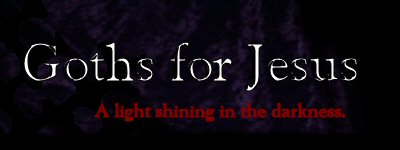|
||||||||
|
The Revolution
"Goth." It can be traced back, in its earliest usage of the term, almost to the time of Christ. It first came on the scene in the 3rd and 4th centuries AD where a Germanic tribe, which had recently migrated from southern Scandinavia to Poland, began to rise in notice among the nations. The Goths made their first stand against the Roman Empire in 238 AD, when they invaded Rome across the Danube. Subsequent invasions ensued, and this barbarian tribe eventually helped bring down the Roman Empire. As the Goths invaded the Empire, they began to plunder the cities and take slaves for themselves. These slaves were often Christians, and as the Goths came into contact with Christianity, it started to take root among the tribe and spread like wildfire. With the translation of the Bible into Gothic by a Goth named Ulfila in the 300's, the Goths became a heavily Christian tribe and abandoned their barbaric and war-mongering ways. To say the least, it was one of the greatest Christian revolutions in the history of the world. Though the modern Goth movement has absolutely nothing to do with the Visigoths of Ancient Europe (except for the name), we can still draw similarities. Today, amongst the modern Gothic community, there is a revolution taking place, and it is becoming more visible and more vocal every day. This is the "Christian Goth" movement, a bud that has taken root and blossomed in the aftermath of the Goth Rock movement. But first, to clear up confusion between all the different usages of the word "goth," let us define and trace the history of the modern goth movement.
The Goth Rock movement has its roots in musical artists and bands from the 60's and 70's such as Velvet Underground, The Doors, Alice Cooper (who later became a Christian), and David Bowie. Though these were not actual Goth bands, they set the tone and the atmosphere that was needed for the Gothic Rock movement to take root. Bands like these heavily influenced young introspective teenagers that would later become the leaders of the Goth movement.
The roots of the modern Christian Goth movement can be traced back to early Christian Punk bands like "Undercover," who came together to release their self-titled album in 1983. In 1982, Robert Sweet and Michael Sweet founded the band "Roxx Regieme"... in 1983, the members of this band became Christians and changed the name to "Stryper," which was ultimately one of the founding Christian Punk leaders. Stryper released their first album in 1984, entitled "Yellow and Black Attack."
It would be right to call Eva O one of the matriarchs of Christian Goth. She was married to the lead singer of Christian Death, Rozz Williams, prior to his suicide in 1998, and she had been involved in the Goth movement as well as Satanism and spirit-consulting. In her testimony, she recounts how she had come to a climax in her dealings with demons, and found herself tormented by them to the point where she couldn't take it anymore. While studying the topic of "angels" for an album called "Demons Fall for an Angel's Kiss," she was offered a book on angelic beings by Billy Graham. She had seriously considered Christianity after reading the book, but the notion soon grew dull in her mind. However, as the demonic torment and suicidal thoughts culminated, she remembered the things she had learned about God and cried out to Him. The demonic visions broke like "glass." Later on, in an interview, she stated, "Oh it makes me want to cry, he is real and no one can change my mind. He has cured me of anxiety attacks. I would have them three times a week. And also from demon possession." Out of the backdrop of these Christian Goth revolutionaries, the movement spread to the Internet where Christian Goth havens were quickly formed, starting with Christiangoth.com in 1997. More soon followed in the early 21st century with ministries like Godscare, The Chalice, and Goths for Jesus. Evidence of the rapid growth of Christian Gothdom is seen by the saturation of the Web with information on Gothic Christianity. Where once it was a rare thing that had to be found amongst a search result of hundreds of pages, now people are finding out about it without even trying.
How long will this age last? How long will the doors remain so open? How long will the Spirit stir through the underground alternative subcultures with such power? The answer: as long as we let it. This Christian revolution in the Goth and Punk communities is the result of thousands of individuals turning to Christ and even more individuals making a consolidated effort to provide hope and answers for the lost kids in the underground communities.
Already, God is establishing a firm stronghold of saints in the underground rock music communities, which is quickly putting to shame the old notions of the neat-pressed 50's era that rock and roll is of the devil, and all who listen to it are obviously not Christians. Some of the most sincere, the most hardcore, and the most passionate spiritual warriors for Christ are emerging from the ranks of the Goth Rock movement. Just as the mighty Visigoths who brought down Rome were swept by the gospel of Christ, so the Goths of this day are turning their lives over to Christ and in doing so, are bringing down the self-righteous, self-seeking, disunified "Rome" of today. The Christian Goths of today have an obligation to do everything with what the Spirit gives us to reach out to the lost, and to swing the scythe. Truly, today, the fields are ripe for harvest. Don't miss out. Main Page |
||||||||
|
|
||||||||
|
Copyright © 2003-2006 Goths for Jesus |



